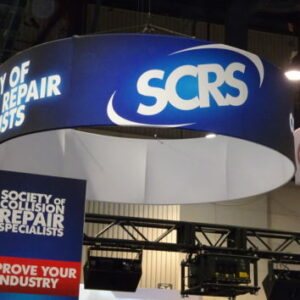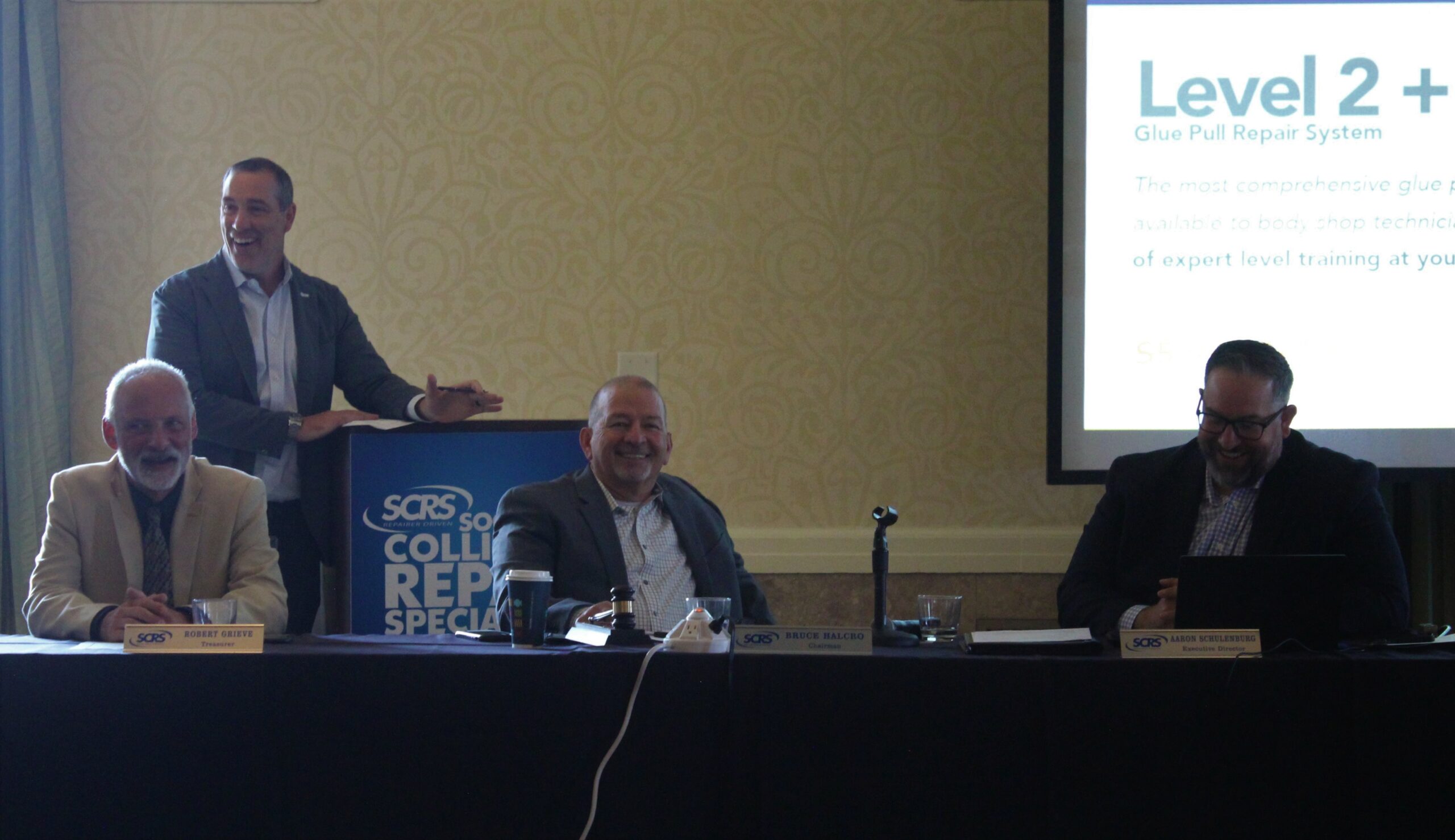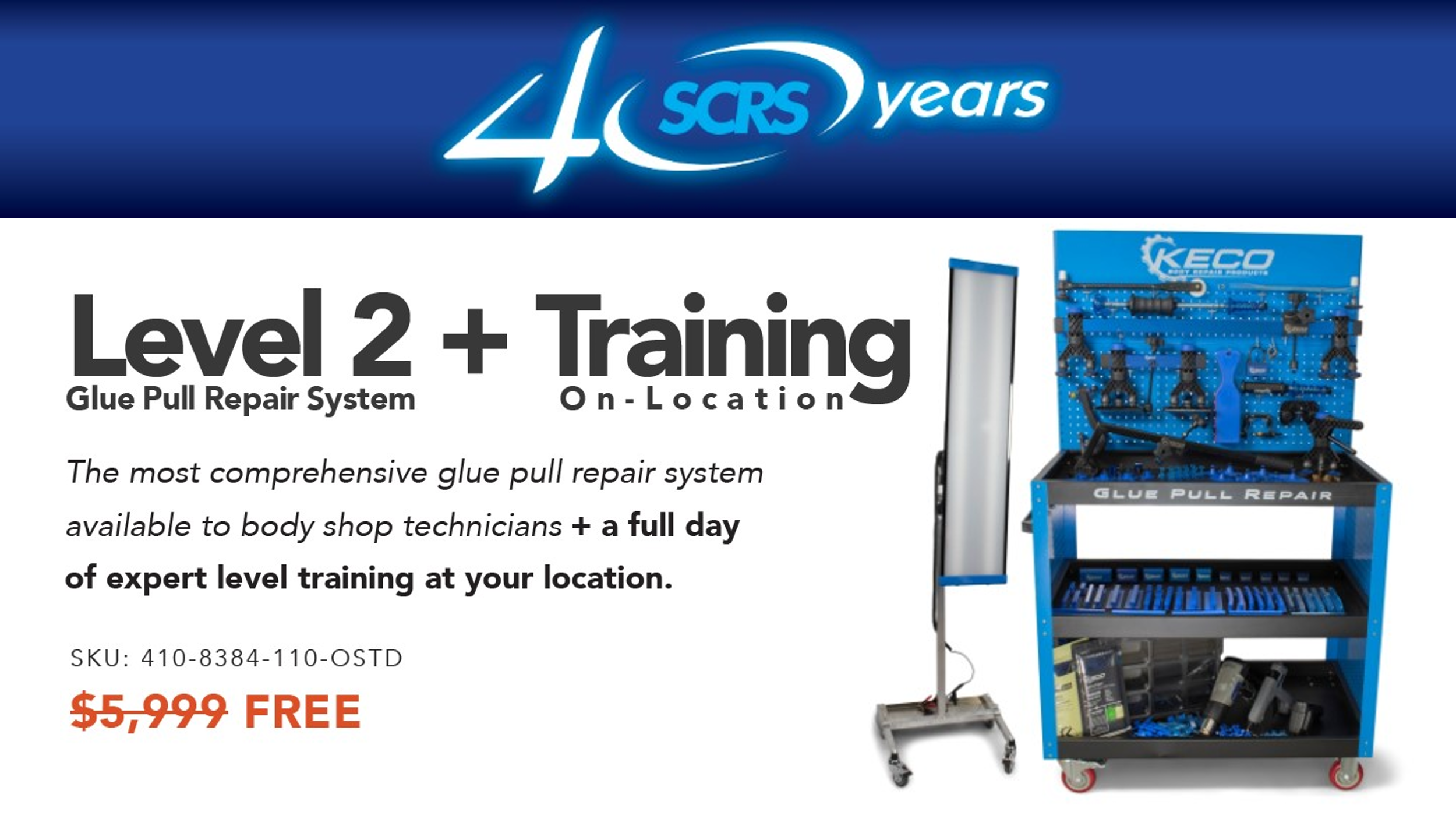
Illinois & Montana colleges receive KECO, SCRS tool & training package
By onAssociations | Collision Repair | Education
The Society of Collision Repair Specialists (SCRS) and KECO Body Repair Products have announced the recipients of a tool and training package to two collision industry educational institutions — an exciting decision for future repairers that exceeds the initial plan to only provide one school with the package.
College of Lake County – Grayslake Campus (CLC)’s Automotive Collision Repair program and City College, Montana State University Billings’ Collision Repair & Refinishing Technology program were each awarded a KECO Level 2 Glue Pull Repair System + On-Location Training. Alliance of Automotive Service Providers of Illinois (AASP-IL) Executive Director Julie Lombardo nominated the College of Lake County program. Montana Collision Repair Association (MCRA) Executive Director Mariah Litton nominated the MSU Billings program.
When KECO President Chris White announced the programs he picked during the July 2022 SCRS open board meeting in Pittsburgh, Pennsylvania he said he was impressed by the high caliber of submissions.
“All of the submissions were compelling,” White said. “I wanted to choose a large market and a small market.”
The $6,000 tool and training package will be given away to an institution every quarter. Schools are nominated by SCRS Affiliate Associations who were encouraged to nominate schools in their market that are delivering valuable programs for their members through an online submission process and selected by KECO, according to an SCRS news release.
The objective of the program is to help provide back to the industry and connect schools and future technicians with associations and collision repair centers. The on-location training at the selected schools is open to association members as space permits.
KECO has also decided to offer a 30% discount on the system for all educational institutions.
CLC’s first collision repair course was delivered in the fall of 1977, “Auto Body Repair 1,” under the Auto Body Repair (ABR) program. By the fall of 2008, the program offered a two-year associate degree program and four specialty certificates with Octavio Cavazos taking the helm as the first full-time instructor to lead the program.
By 2010, the ABR program course offerings expanded to include the delivery of both day and night course schedules and, in 2013, the program shifted to “Automotive Collision Repair Technology (ACR)” with an updated course lineup. The ACR program curriculum includes I-CAR curriculum, manufacturer-specific repair procedures, and follows the NATEF Collision Repair Tasks for all areas of collision repair.
“The ACR program is constantly improving,” Lombardo said in the release. She said the latest technologies included in the curriculum are detailing out water-borne refinishing, aluminum panel repair processes and aluminum welding as well as advanced driver assistance systems (ADAS) training.
“We moved away from stud pulling many years ago because it wasn’t the proper procedure for today’s advanced vehicles,” Cavazos said in the release. She now serves as the department chair in addition to being an instructor.
“We haven’t had a proper repair procedure for dent pulling since moving away. After researching, we discovered glue pulling is now the viable repair method. In order to safely teach dent repair to our students, we decided this was the method we would go with. In implementing this into the curriculum, we selected KECO’s system because it was versatile and best equipped to deliver dent pulling at an educational facility. With KECO equipment, we can introduce, instruct, and master the skill in a short period of time.
“The fact that our training program has also been selected in return by KECO only proves that it is as innovative and advanced as we strive to achieve. Besides being chosen, the training we are receiving from them is an opportunity that is truly priceless. Long after that day, the impact of this training will be felt. As our students begin their careers, they will have the opportunity to take this hands-on manufacturing training into the industry, and our instructors will be able to teach it to the next generation of students for years to come.”
There are two other full-time program instructors – David Garcia and Donald Myers – who are now supported by five adjuncts that come from various backgrounds in the collision repair industry.
“AASP-I is committed to the cutting-edge technological advancement of the collision repair industry,” AASP-I President Bob Gottfred said in the release. “The synergies represented in introducing the KECO Advanced Glue Pulling System at the College of Lake County are emblematic. Merging high-end technical training at the college level prepares graduating students with the knowledge to hit the ground running in their careers. It is a win-win for shop owners and apprentices as well. Helping to provide training and career paths for new dedicated, quality collision repair technicians is a paramount priority of AASP-I. We are delighted to know that SCRS and KECO are providing the framework for this, and to work with the fantastic team at CoLC to advance our common goals.”
In the fall of 2020, the ACR program launched its apprenticeship program in partnership with Collision Engineering.
The nomination from MCRA for MSU Billings stood out to White because its Collision Repair & Refinishing Technology program is the only remaining collision repair program in Montana.
“Mr. Steve Wodrich has worked extremely hard to cultivate a program that creates top-notch collision repair professionals,” Litton said in the release. “This requires immense efforts on his part. Steve works tirelessly to not only recruit new students to the program but to help his current students excel. Steve is constantly meeting with Collision Repair Facility owners and managers to discuss the structure of his program. He works relentlessly to make sure his program is top-notch. This, in part, requires Steve to rely on the generosity of donors to help provide funding and equipment. When Steve is lacking funding or equipment, he makes up for it by providing the highest caliber educational experience possible.”
Litton described Wodrich as being “diligent” about connecting and working with the MCRA to ensure his students are trained to meet the needs of any collision repair facility they work at after graduating from his program.
“Mr. Wodrich’s dedication to teaching his students how to be masters of their craft is clear in their success within the industry and at Skills USA. Collision Repair facility owners and manners are constantly singing Steve’s praises. Saying that his students are well prepared, professional, and well versed on the importance of following OEM guidelines. Steve makes a point of engraining the need to perform safe and proper repairs for all his students.”
Litton added that in addition to being excellent candidates for employment – with a focus on safe and proper repairs – students who have attended the City College MSU Billings Collision Repair & Refinishing Technology are often the top-tier competitors at Skills USA, including Dylan Miller, who claimed first in Automotive Refinishing Technologies at this year’s competition.
“Steve works extremely hard to ensure his students have access to all of the current OEM repair procedures, I-CAR training procedures, and equipment” despite having the largest budget to allocate for equipment, she said.
Wodirch thanked SCRS and KECO for choosing MSU Billings’ auto body program to receive the tools and training. “The biggest struggle I face in running this program is having enough budget to get the latest tools and training possible. If it were not for the generosity of companies like KECO I do not know how I would be able to maintain the resources needed to continue training future technicians. This will be a tremendous help to us as we move forward.”
SCRS Board Chairman Bruce Halcro SCRS, who also owns Capital Collision in Helena, Montana and is a past MCRA chairman, said he’s “beyond excited” for students in his home state.
“This is a great opportunity to have some of the latest repair technology available for students in Montana, and Chris and his team at KECO are doing a great service to the collision industry in making their equipment available to the students preparing for a future in our industry. I’m grateful we can be a part of it at SCRS, and I’m really excited for Steve and his school. Great job to Mariah for the thoughtful nomination of City College.”
The KECO Level 2 GPR System is a complete solution from rough out to finish in dent repair, according to the release. The system works equally well on both steel and aluminum panels. The surface area and variety of shapes in the pulling tabs create the “least invasive and most efficient” dent repair possible today while also not creating collateral damage during repairs.
The system allows large dents to be efficiently reduced to a ready-for-glaze state and small hail-type dents to be brought to a filler-less level and ready for paint.
The KECO 6C Process is the foundation for the one-day training course that will enable students to become effective GPR technicians, the release states. The KECO metal manipulation theory is rooted in the concept of creating metal flow through efficient movement of low areas and the simultaneous reduction of high areas of the dent. The in-classroom theory will be proven hands-on in the shop immediately following the classroom presentation.
The next school(s) selected will be announced by SCRS during the 2022 SEMA Show in Las Vegas, Nevada.
For more information about SCRS, or to join as a member, visit scrs.com, call 1-877-841-0660, or send an email to info@scrs.com.
IMAGES
Featured image: The Society of Collision Repair Specialists logo over its SEMA 2017 booth. (John Huetter)
(Left to right) KECO President Chris White, SCRS Chairman Bruce Halcro, and SCRS Executive Director Aaron Schulenburg during the board’s July 20 open meeting.
Slide detailing KECO’s Level 2 Glue Pull Repair System provided for use by SCRS.


